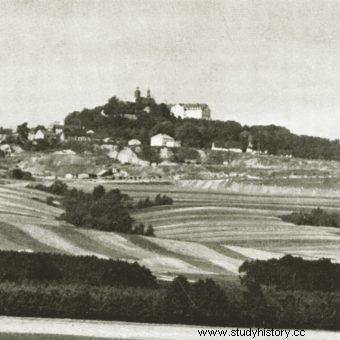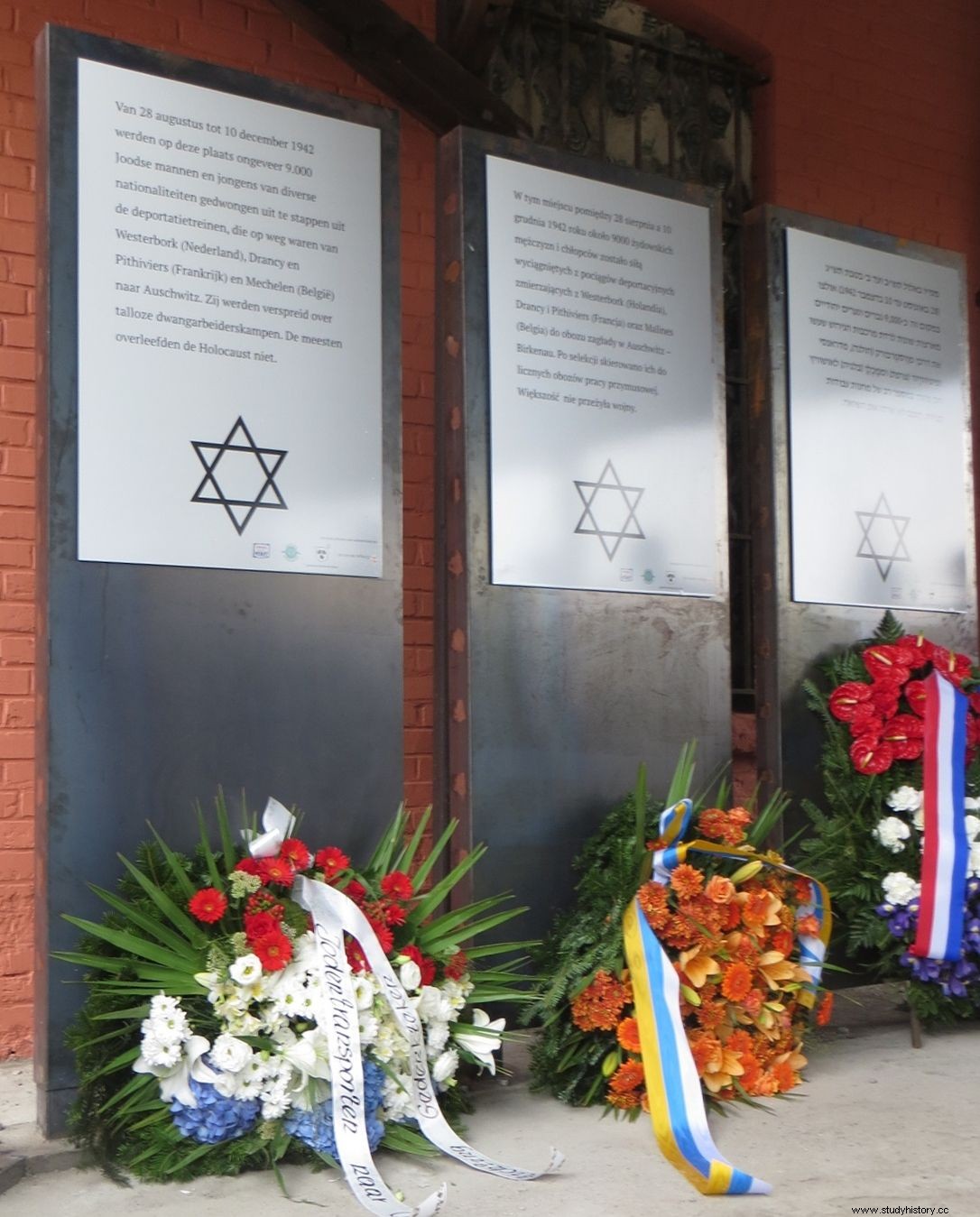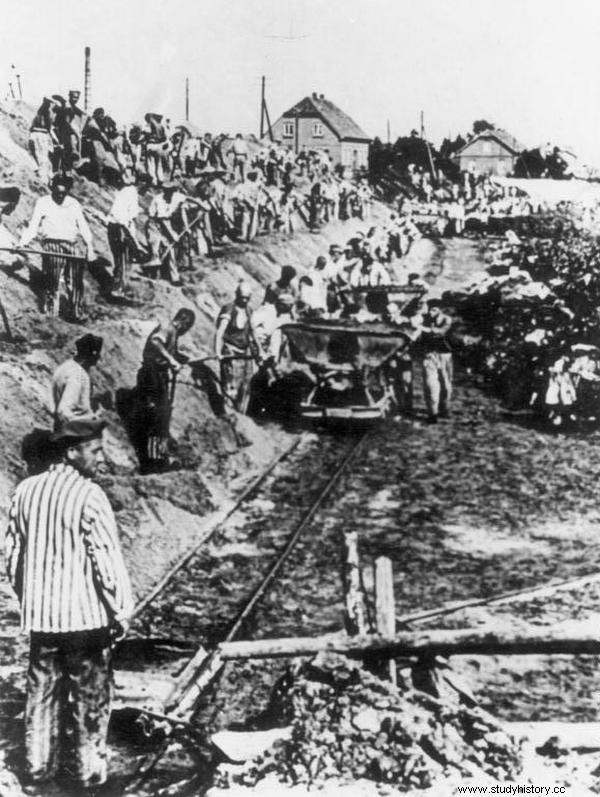For the Nazis, a concentration camp prisoner had no value as a human being, but at best as a walking tool. This ruthless organization has perfected a business model based on slave labor and extreme exploitation. She earned a lot, because it turned out that there are many buyers of almost free workers in German industry.
For the giants of German industry, World War II became an opportunity to attract cheap labor. The largest companies of the Third Reich, such as I.G. Farbenindustrie or the Krupp factory used prisoners sent to concentration camps and work. Many projects that had started before the outbreak of the global conflict were completed in this way. One of them was the construction of a motorway connecting Berlin, Wrocław, Gliwice and - after the creation of the Governorate - Kraków, which started in the 1930s.
100,000 free workers
Work on the road accelerated after the creation of labor camps in which forced laborers were imprisoned. The first three so-called Reichsautobahnlagers or in short, RAB-Lagers (i.e. camps used to build highways) were established in the Katowice and Opole districts as early as 1939. Initially, it was assumed that their life would be rather short. However, the benefits of this type of exploitation of prisoners prompted the head of the SS, Heinrich Himmler, to expand the entire enterprise.

St. Anne's Mountain. It was there that in 1940 one of the camps supervised by the Schmelt Organization was established. Photo from the mid 1930s.
In an official letter of September 1940, he ordered that all Jews from Upper Silesia should be used to work in quarries and road construction. It was a huge group of the population. In 1939 it was estimated at around 100,000 people!

The construction of the motorway network required thousands of workers. The Nazis willingly used prisoners of camps supervised by the Schmelt Organization for this purpose.
Albrecht Schmelt was entrusted with the task of creating a network of camps that would "hire" workers for various types of work. His name is the source of the organization established at the end of 1940 - the Organization Schmelt. Its main seat was in Sosnowiec. The entire undertaking was managed by the Upper Silesian SS, which drew considerable profits from this.
Schmelt himself was a exemplary Nazi and protégé of Himmler . Thanks to his support, he climbed up in the administration of the Third Reich. First, he became the representative of the Reichsführer of the SS and the head of the German police for the employment of foreign nationalities in Upper Silesia. Then, in 1941, he was promoted to the president of the Opole region. His organization developed simultaneously. In 1940, 35 labor camps were established, in 1941 - another 16, in 1942 - 24, and in 1943 - 8.
Soon, the network of labor camps organized by a German official went beyond Upper Silesia. 52 camps operated in the Lower Silesia Province, and 17 in the Sudetes. How many were all? To this day, it is difficult to determine. In German literature, we find information about 177 camps, while the works of Polish historians mention 162 facilities.
Rather, it should be assumed that this number has changed over time. It was influenced, for example, by the takeover of some of the centers of the Schmelt Organization by larger concentration camps , such as Gross-Rosen and Auschwitz-Birkenau. After all, they were located in the immediate vicinity of industrial plants important from the point of view of the Third Reich. Such cases occurred especially after 1942.
Not only Jews
In the camps managed by the organization, there were mainly representatives of the Upper Silesian Jewish minority. The fact that the seat of Schmelt was located in the immediate vicinity of the Judenrat in Sosnowiec was not without significance for the effective fishing of "workers". The chairman of the Headquarters of Jewish Elders' Councils in Eastern Upper Silesia, Moses Merin, also cooperated.
Schmelt's Jews, as that name became commonplace in literature, were employed not only in the construction of the motorway, but also in other industries. From the spring of 1941, they appeared in factories responsible for the arms and textile industries. They were also present in mines and heavy industry.
It is estimated that at its peak, in 1943, there were as many as 50,000 prisoners in the centers of the organization. It should be noted, however, that at that time they were not only Jews from Upper Silesia.

Plaques at the Koźle station commemorating transports of Western European Jews that ended up in the Arbeitslager Annaberg, among others.
Jews from all over Europe, Poles, Dutch, Czechs and Austrians were sent to the camps subordinate to Schmelt. There were several hundred prisoners in each colony. The largest, Brande in Prądy, housed 600 of them. In Annenberg on Góra Św. Anna, there were 400 people, and Auenrode in Osiek - 300.
"Women were cleaning up like good housewives ..."
In some sources you can find information that the work in the units of Organization Schmelt was easier than elsewhere. This theory is confirmed by the words of Sara Garncarz, a former prisoner from Geppersdorf (now Milęcice), who recalls:
The men went to nearby construction sites every morning, and the women like good housewives did the cleaning and cooking after their husbands left for work. In the afternoon, each prisoner was issued with special food stamps, which contained a specific amount of bread, butter and soup that they were to receive.
Nothing could be more wrong. The position of the prisoner, as in other labor and concentration camps, resulted in a way from the role he played and the tasks that he had to perform. Besides, the organization of all camps under Schmelt corresponded to the one adopted by the Oranienburg Concentration Camp Headquarters. It was still one of the elements of the Nazi extermination system . The prisoners worked in inhumane conditions. They dealt with collecting the surface, loading it on carts, laying rails on tracks or clearing the forest.

Working beyond strength was one of the Nazi methods of exterminating concentration camp prisoners. Illustrative photo.
Work was done without specialized equipment. The prisoners carried huge logs of trees for many kilometers. The average length of work in the summer period was from 12 to 14 hours, and in the winter it was 8-10 hours. It was not difficult to find an accident, in addition, not everyone was recorded in the file. Occasional free Sundays were mainly devoted to linen washing and general cleaning.
In the accounts of many forced laborers, there is information that the sanitary conditions in the camps were terrible. Inmates lacked medical care and the centers were swarming with disease-causing vermin. In addition, there was hunger. As noted by former prisoner Rudolf Schoenberg, who worked on the highway construction, daily food rations consisted of 200-400 grams of hard bread and watery soup . Occasionally 25 grams of margarine was obtained. It is not surprising, since the Schmelt Organization allocated only ... 0.90 marks to feed one person.
Prisoner =money
The savings that the Nazi organization made at every step - meager food, lack of appropriate clothing and tools - had nothing to do with the financial benefits it was getting. The cost of maintaining a prisoner oscillated around 1.5 marks a day, while for hiring a skilled worker, the cost of hiring a skilled worker was an average of 6 marks a day . The unskilled worker was only slightly cheaper - it cost 4.5 marks. Interestingly, the rates that Schmelt proposed for "his" Jews became binding in the entire camp system after 1942.

The slave labor of the prisoners brought enormous profits to the Nazis.
It is easy to calculate that the income that Schmelt's company received from renting prisoners was enormous. The company Aloys Hesse, operating in Parschnitz, paid between 20 and 21 thousand marks a month for renting from 300 to 310 prisoners. Thanks to this and other "customers" in September 1942 there were 11.5 million marks in the organisation's bank account.
So much money seemed to be a tasty morsel for many. Albrecht Schmelt himself was tempted as well, which was the cause of his downfall. In 1944, he lost the position of the president of the Opole region, and then he was brought before a court for abuses. After this scandal, Himmler's former favorite most likely holed up in his estate near Opole. When the war ended, he went to Szklarska Poreba, where he committed suicide.
The organization managing the network of camps did not live to see the end of the war. As early as 1942, a decline in the support given to her by the SS leaders was noticeable. This was mainly due to the interruption of works on the construction of motorways. Lagoons were gradually closed. In the years 1942-1943 as many as 51 of them ceased to function. Another 23 centers were shut down in 1944. It was the beginning of the end of Schmelt's empire.
Inspiration:
This article was inspired by the latest novel by Maciej Siembieda, entitled Place and Name , Capital Letter 2018.
